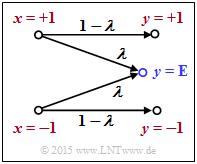Exercise 4.1Z: Log Likelihood Ratio at the BEC Model
Wir betrachten das so genannte BEC–Kanalmodell (Binary Erasure Channel) mit
- der Eingangsgröße $x ∈ \{+1, \, -1\}$,
- der Ausgangsgröße $y ∈ \{+1, \, -1, \, {\rm E}\}$, und
- der Auslöschungswahrscheinlichket $\lambda$.
Hierbei bedeutet $y = {\rm E}$ (Erasure), dass der Ausgangswert $y$ weder als „$+1$” noch als „$-1$” entschieden werden konnte.
Bekannt sind zudem die Eingangswahrscheinlichkeiten
- $${\rm Pr}(x = +1) = 3/4\hspace{0.05cm}, \hspace{0.2cm}{\rm Pr}(x = -1) = 1/4\hspace{0.05cm}.$$
Das Log–Likelihood–Verhältnis (kurz: $L$–Wert, englisch: Log Likelihood Ratio, LLR) der binären Zufallsgröße $x$ ist bei bipolarer Betrachtungsweise wie folgt gegeben:
- $$L(x)={\rm ln} \hspace{0.15cm} \frac{{\rm Pr}(x = +1)}{{\rm Pr}(x = -1)}\hspace{0.05cm}.$$
Entsprechend gilt für den bedingten $L$–Wert in Vorwärtsrichtung für alle $y ∈ \{+1, \, -1, \, {\rm E}\}$:
- $$L(y\hspace{0.05cm}|\hspace{0.05cm}x) = {\rm ln} \hspace{0.15cm} \frac{{\rm Pr}(y\hspace{0.05cm}|\hspace{0.05cm}x = +1)}{{\rm Pr}(y\hspace{0.05cm}|\hspace{0.05cm}x = -1)} \hspace{0.05cm}. $$
Hinweise:
- Die Aufgabe gehört zum Kapitel Soft–in Soft–out Decoder.
- Bezug genommen wird insbesondere auf die Seite Zuverlässigkeitsinformation – Log Likelihood Ratio sowie auf die Seite Binary Erasure Channel.
Fragebogen
Musterlösung
- $$L(x)={\rm ln} \hspace{0.15cm} \frac{{\rm Pr}(x = +1)}{{\rm Pr}(x = -1)} ={\rm ln} \hspace{0.15cm} \frac{3/4}{1/4}\hspace{0.15cm}\underline{= 1.099}\hspace{0.05cm}.$$
(2) Entsprechend der Definition
- $$L(x)={\rm ln} \hspace{0.15cm} \frac{{\rm Pr}(x = +1)}{{\rm Pr}(x = -1)}$$
ergibt sich für $L(x) = \, -2$ die folgende Bestimmungsgleichung:
- $$\hspace{0.15cm} \frac{{\rm Pr}(x = +1)}{1-{\rm Pr}(x = +1)} \stackrel{!}{=}{\rm e}^{-2} \approx 0.135 \hspace{0.25cm}\Rightarrow \hspace{0.25cm} 1.135 \cdot {\rm Pr}(x = +1)\stackrel{!}{=}0.135\hspace{0.3cm} \Rightarrow \hspace{0.3cm} {\rm Pr}(x = +1) = 0.119\hspace{0.05cm},\hspace{0.4cm}{\rm Pr}(x = -1) \hspace{0.15cm}\underline{= 0.881}\hspace{0.05cm}. $$
(3) Für den bedingten $L$–Wert $L(y = {\rm E} | x)$ in Vorwärtsrichtung gilt beim vorgegebenen BEC–Modell:
- $$L(y = {\rm E}\hspace{0.05cm}|\hspace{0.05cm}x) = {\rm ln} \hspace{0.15cm} \frac{{\rm Pr}(y= {\rm E}\hspace{0.05cm}|\hspace{0.05cm}x = +1)}{{\rm Pr}(y= {\rm E}\hspace{0.05cm}|\hspace{0.05cm}x = -1)} = {\rm ln} \hspace{0.15cm} \frac{\lambda}{\lambda}\hspace{0.15cm}\underline{= 0}\hspace{0.05cm}.$$
(4) Analog zur Musterlösung der Teilaufgabe (3) erhält man für $y = ±1$:
- $$L(y = +1\hspace{0.05cm}|\hspace{0.05cm}x) \hspace{-0.15cm} \ = \ \hspace{-0.15cm} {\rm ln} \hspace{0.15cm} \frac{{\rm Pr}(y= +1\hspace{0.05cm}|\hspace{0.05cm}x = +1)}{{\rm Pr}(y= +1\hspace{0.05cm}|\hspace{0.05cm}x = -1)} = {\rm ln} \hspace{0.15cm} \frac{1-\lambda}{0}\hspace{0.15cm}\underline{ \hspace{0.05cm}\Rightarrow \hspace{0.15cm}+\infty }\hspace{0.05cm},$$
- $$L(y = -1\hspace{0.05cm}|\hspace{0.05cm}x) \hspace{-0.15cm} \ = \ \hspace{-0.15cm} {\rm ln} \hspace{0.15cm} \frac{{\rm Pr}(y= -1\hspace{0.05cm}|\hspace{0.05cm}x = +1)}{{\rm Pr}(y= -1\hspace{0.05cm}|\hspace{0.05cm}x = -1)} = {\rm ln} \hspace{0.15cm} \frac{0}{1-\lambda}\hspace{0.15cm}\underline{ \hspace{0.05cm}\Rightarrow \hspace{0.15cm}-\infty }\hspace{0.05cm}. $$
Richtig sind demnach die Lösungsvorschläge 1 und 2.
(5) Richtig ist der letzte Lösungsvorschlag:
- Für $\lambda = 0$ (idealer Kanal) ergibt sich $L(y = {\rm E} | x) = \ln {(0/0)}$ ⇒ unbestimmtes Ergebnis.
- Für $\lambda = 1$ (vollständige Auslöschung, $y ≡ {\rm E}$) sind $L(y = +1 | x)$ und $L(y = \, -1 | x)$ unbestimmt.
